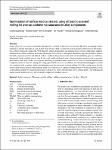Thông tin tài liệu
Thông tin siêu dữ liệu biểu ghi
| Trường DC | Giá trị | Ngôn ngữ |
|---|---|---|
| dc.contributor.author | Lorenz, Engelking | - |
| dc.contributor.author | Antonia, Eissel | - |
| dc.contributor.author | Dirk, Schroepfer | - |
| dc.date.accessioned | 2023-04-19T07:20:42Z | - |
| dc.date.available | 2023-04-19T07:20:42Z | - |
| dc.date.issued | 2023 | - |
| dc.identifier.uri | https://link.springer.com/article/10.1007/s00170-023-11326-z | - |
| dc.identifier.uri | https://dlib.phenikaa-uni.edu.vn/handle/PNK/8086 | - |
| dc.description | CC BY | vi |
| dc.description.abstract | Nickel alloys are cost intensive materials and generally classified as difficult-to-cut material. However, machining of these materials is needed especially in case of alloy 36 (1.3912), which is commonly used in mould construction for the production of fibre-reinforced composites. With regard to repair, modification and manufacturing of such components, additive manufacturing offers significant economic advantages. Nevertheless, subsequent machining steps are needed to achieve the final component contour and defined surface conditions. Dependent on the material and machining process conditions, detrimental tensile residual stresses may be the result on the machined surface, having negative impact on the component performance and safety. | vi |
| dc.language.iso | vi | vi |
| dc.publisher | Springer | vi |
| dc.subject | ultrasonic-assisted milling | vi |
| dc.subject | Ni alloy components | vi |
| dc.title | Optimisation of surface residual stresses using ultrasonic-assisted milling for wire-arc additive manufactured Ni alloy components | vi |
| Bộ sưu tập | ||
| OER - Kỹ thuật điện; Điện tử - Viễn thông | ||
Danh sách tệp tin đính kèm:

